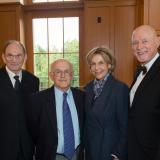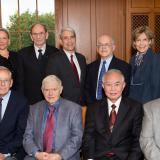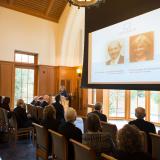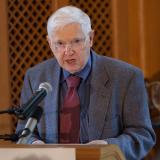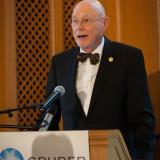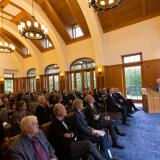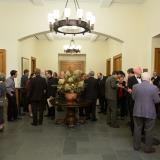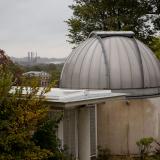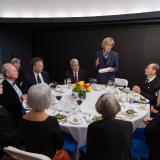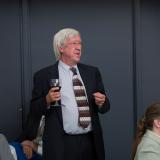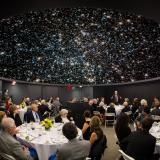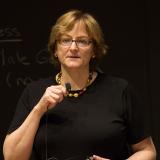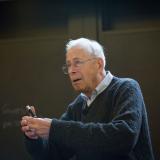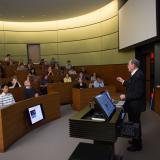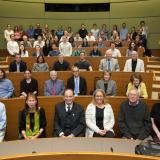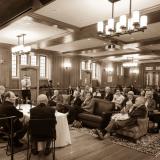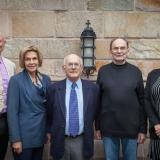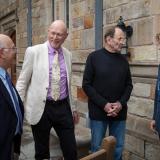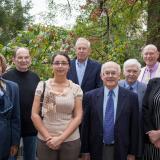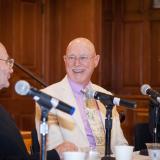2014 Gruber Cosmology Prize
By establishing a connection between observations of the nearby universe with the universe on the whole, Jaan Einasto, Kenneth Freeman, R. Brent Tully, and Sidney van den Bergh pioneered Near Field Cosmology—an area of study that helped establish both that the distribution of galaxies is not random but has a definite structure, and that dark matter played a key role in the evolution of that structure.
2014 Cosmology Prize Recipients
Laureate Profile
The 2014 Gruber Prize in Cosmology honors the pioneers in a discipline that might at first seem oxymoronic: Near Field Cosmology. Isn’t cosmology the study of the structure and evolution of the universe on the largest scales? What could the relatively nearby universe—our galaxy and a handful of neighbors—tell us about how the 100 billion other galaxies have arranged themselves over the universe’s 13.75 billion year history?
Plenty—and Jaan Einasto, Kenneth Freeman, R. Brent Tully, and Sidney van den Bergh were the pioneering astronomers who established that connection.
When they began their work in the third quarter of the twentieth century, the science of cosmology was still new. The twin discoveries that the universe consists of galaxies beyond our own and that the universe is expanding date only to the 1920s. Among the fundamental open questions in cosmology at the time were: Is the distribution of galaxies in an expanding universe more or less random, like shrapnel from a grenade? Or has gravitational interaction among the galaxies determined the structure of the universe? As Tully says, “Everything is changing all the time”—astronomers just didn’t know in what way or how much.
Yet even as their colleagues were racing to make discoveries at greater and greater distances across the universe, the 2014 Gruber Prize recipients were gradually realizing that the relatively nearby universe could provide answers as well.
Van den Bergh determined the distance to our neighboring Andromeda galaxy, thereby establishing one of the first rungs on the cosmic distance ladder—a ladder he would continue to “climb” throughout his career (and a fitting vocation for someone who remembers as a child trying to touch the Moon with a stick and failing, and wondering just how big the universe is). Through further observations of Andromeda, he also found evidence that the stars in the outer reaches of the spiral were so old that they must be remnants from galaxies that had merged with Andromeda, suggesting that galaxy mergers play a fundamental role in galaxy evolution.
Around this time, nearby galaxies were also drawing the attention of Freeman and Einasto. Both noticed that the rotation rates for spiral galaxies were so rapid that the disks should be shedding gas and stars. Their solution: The galaxies are suffused in a massive envelope or halo of an otherwise unobservable substance—what came to be known as dark matter—that keeps the disk in equilibrium.
The two approaches to cosmic evolution—the distant and the nearby—finally converged at a 1977 conference in Tallinn, Estonia, that Einasto organized specifically for that purpose. He called the conference “The Large-Scale Structure of the Universe,” though the idea was still so new that, as he later wrote, “we had no idea what this term actually means.” Nonetheless, it stuck—and with good reason. At that conference Einasto and his collaborators presented the first evidence that not only does the galaxy distribution in the universe show a definite structure, but the pattern seems distinctly web-like.
That same year Tully, along with collaborator J. Richard Fisher, discovered a way to calculate distances to galaxies. Measure the mass of a galaxy, and you’ll know the galaxy’s intrinsic brightness; compare the intrinsic brightness with its observed brightness, and you’ll know its distance (much as you could calculate the distance of a light bulb if you knew its wattage). The Tully-Fisher relation, to this day a standard tool in cosmology, would allow astronomers to endow the universe with a third dimension.
Today that three-dimensional view encompasses nearly the entirety of the 13.75-billion-year history of the universe. It’s a universe that resembles a web—filaments of galaxies and superclusters of galaxies separated by vast voids of empty space. It’s a universe that couldn’t have evolved into a web without the gathering gravitational forces of dark matter. And it’s a universe that has been defined, in large part, through Near Field Cosmology.
Watch Video
Citation
The Gruber Foundation proudly presents the 2014 Cosmology Prize to Jaan Einasto, Kenneth Freeman, Brent Tully and Sidney van den Bergh for their pioneering contributions to the understanding of the structure and composition of the nearby Universe.
Their work laid the foundations of Near Field Cosmology. They clarified the properties of nearby galaxies -- dwarfs, spirals, lenticulars and ellipticals -- through studies of their morphology, stellar and gaseous content. The early recognition of the role of dark matter, and of the filamentary clustering of galaxies together with setting the distance scale of galaxies was crucial in setting the cosmological context for our current understanding of the evolution of galaxies and large-scale structure.







